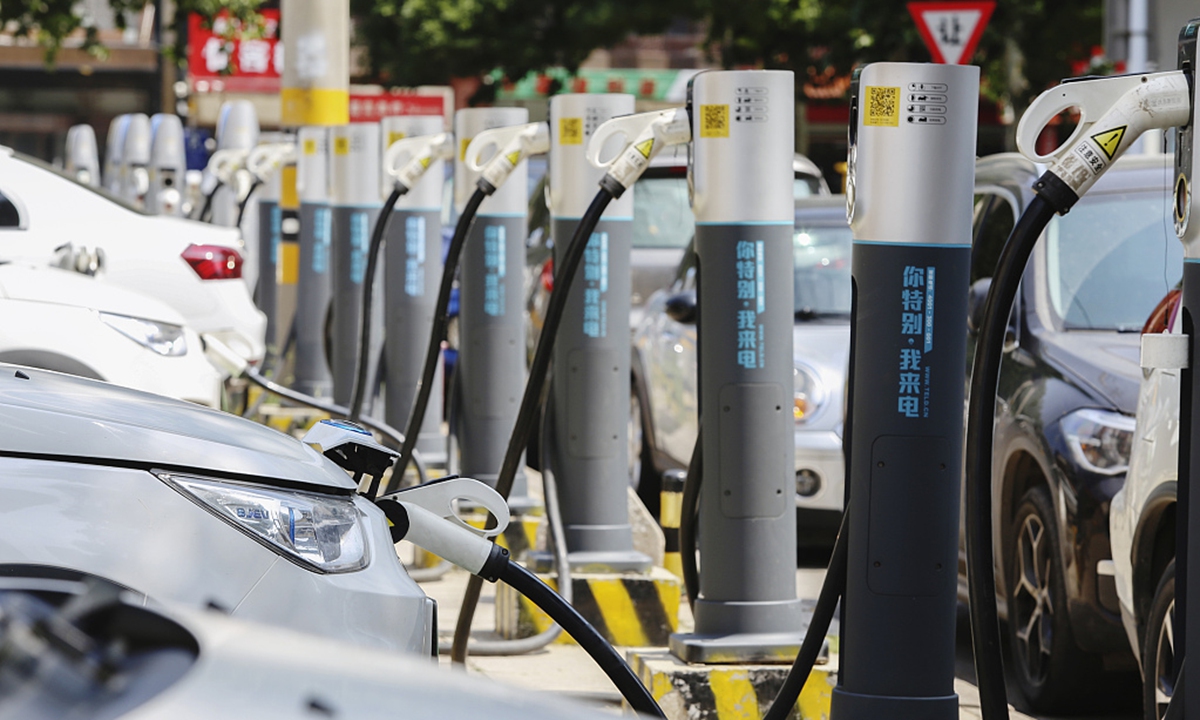Pure electric vehicles feel charging pinch on highways during National Day holidays

Photo: VCG
Some new-energy vehicle (NEV) owners have felt another pinch during the ongoing National Day holidays apart from the normal traffic jams during traditional Chinese holidays when many people hit the road: they are finding it hard to get their electric vehicles (EVs) charged at services zones along highways.
An EV owner reportedly queued for four hours in a services zone in Leiyang, Central China's Hunan Province where many cars waited for charging on October 1, the first day of the long holidays when the traffic peak usually occurs on highways. The owner drove her car from Shenzhen, South China's Guangdong Province, to Hunan. The distance between Shenzhen and Hunan is about 750 kilometers.
During the four hours, the owner said she did not go to the bathroom worrying if another car would jump the queue, according to media reports. "There were about 20 cars in the queue and I assume it would be about three hours of waiting," she said. It took her 16 hours to finally get home.
"Although it is an individual phenomenon, it can still reflect the current problem that our charging infrastructure needs to improve," Cui Dongshu, secretary general of the China Passenger Car Association, told the Global Times on Tuesday.
Latest data from China's State Grid showed that the daily charging capacity of domestic highways hit a record high, nearly four times the usual during the long holidays this year.
The total charging capacity of the State Grid's charging and swapping services network increased by 59 percent year-on-year during the first three days of the holidays. Among them, the charging capacity of on highway charging facilities increased by 56.52 percent on a yearly basis.
A Beijing-based white-collar worker surnamed Li who drove his EV on highways from Beijing to his hometown in neighboring Hebei Province told the Global Times on Tuesday that charging piles usually stay idle in non-holiday periods and there is usually enough power to use.
"I often check on my phone in advance to see if a services zone has available charging piles or not and then plan my roadmap," Li said, suggesting that software and hardware should be more effectively combined to offer better services for EV users.
At present, the number of charging piles on highways across the country has reached 10,836, and service areas with charging piles are registered at 2,318, according to a press conference from the Ministry of Transport in September.
Cui said that it is also a good sign to see that the number of trips on NEVs during holidays increased significantly, which proved that new green mobility is getting more popular among Chinese consumers.
China is accelerating its pace in building the nation into a green automotive powerhouse. At the end of June, the number of NEVs across the country reached 6.03 million, accounting for 2.1 percent of the total number of vehicles, data from the Ministry of Public Security showed. Among them, there are 4.93 million pure EVs, accounting for 81.7 percent of the total number of NEVs.
Boasting the world's most sizable inventory of NEVs, China accounts for 55 percent of global NEV sales.
By 2035, pure EVs are likely to become mainstream in the sales of new NEVs, while those used in public transportation will be exclusively electrified, according to a development plan for the NEV industry from 2021-2035 unveiled by the State Council, China's cabinet, in November 2020.
Apart from improving charging facilities, Cui suggested that more NEVs with longer range could be put onto the market.
In the current market environment, most users' EVs have a range of only about 400 kilometers on average, and the fast charge has still not reached a level of more than ten minutes.
Global Times

